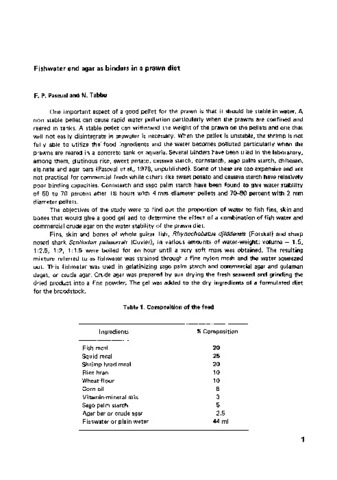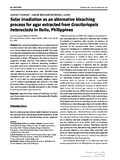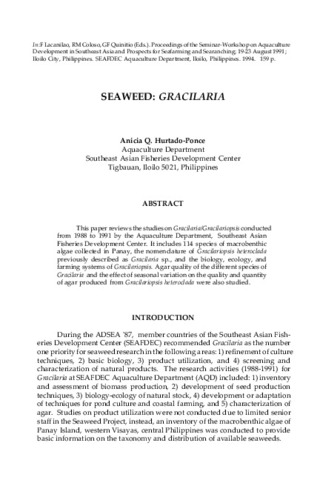Use of agar-bound microparticulate diet as alternative food for tropical abalone, Haliotis asinina (Linnaeus 1758) post-larvae in large-scale cultures
- Global styles
- MLA
- Vancouver
- Elsevier - Harvard
- APA
- Help

ดู/เปิด
วันที่
2017ผู้เขียน
Page views
802ASFA keyword
AGROVOC keyword
เมตาดาต้า
แสดงระเบียนรายการเต็มCited times in Scopus
- Citations
- Scopus - Citation Indexes: 4
- Captures
- Mendeley - Readers: 8
Share
นามธรรม
The efficacy of using agar-bound microparticulate diet (A-MPD) as alternative food for abalone Haliotis asinina Linne post-larvae in large-scale culture was investigated. Larvae sourced from the hatchery-bred (HB) and wild-sourced (WS) broodstock were fed with either diatoms (TMT1-NF), agar-bound microparticulate diet (TMT2-A-MPD), or a combination of both feeds (TMT3-NF + A-MPD) in six 2-m3 tanks replicated over time. Three hundred thousand veliger larvae were stocked/tank containing 80 corrugated plates with mucus trails hanging on bamboo poles. Feeds were given at 0900 h starting at day 3 with seawater flow through introduced every 1400 h starting day 5. Two-way analysis of variance determined significant differences (p < 0.05) in survival and shell length between larval sources and feed types. Tukey’s post hoc test established differences among treatment means. At day 30, survival for HB- and WS-sourced larvae was significantly higher (42%) in TMT3 compared with TMT2 having 35% for HB and 38% for WS (p < 0.05). Larvae fed with TMT1 had significantly lowest survival among the three treatments. Survival at 60 and 90 days did not show significant difference for TMT2 and TMT3 regardless of broodstock source. Post-larval shell growth (90 days), from both sources fed with TMT2 and TMT3, was significantly higher than TMT1 (p < 0.05). Larval performance did not show any significant interactions between HB and WS broodstock. The use of A-MPD alone or in combination may elicit improvement in survival and shell length growth in abalone larvae regardless of larval sources. A-MPD may be used as full or partial replacements to diatoms as alternative food for abalone post-larvae in large-scale culture.
การอ้างอิง
Bautista-Teruel, M. N., Maquirang, J. R. H., de la Peña, M. R., & Balinas, V. T. (2017). Use of agar-bound microparticulate diet as alternative food for tropical abalone, Haliotis asinina (Linnaeus 1758) post-larvae in large-scale cultures. Aquaculture International , 25(3), 1239-1252. https://doi.org/10.1007/s10499-017-0110-9
Type
ArticleISSN
0967-6120; 1573-143Xคอลเลกชัน
- Journal Articles [1247]
Related items
Showing items related by title, author, creator and subject.
-
Fishwater and agar as binders in a prawn diet
Pascual, F. P.; Tabbu, N. (Aquaculture Department, Southeast Asian Fisheries Development Center, 1979)The objectives of the study were to find out the proportion of water to fish fins, skin and bones that would give a good gel and to determine the effect of a combination of fish water and commercial crude agar on the water ... -
Solar irradiation as an alternative bleaching process for agar extracted from Gracilariopsis heteroclada in Iloilo, Philippines
Endoma, Leonilo F.; Nacional, Loda M.; Luhan, Maria Rovilla J. (De Gruyter, 2019-07-30)The current industrial practice of using chemical bleach to achieve the pure white colour of agar is deleterious to both human and environmental health. This study evaluates the potential of solar irradiation as an alternative ...88 Total citations3 Recent citationsn/a Field Citation Ration/a Relative Citation Ratio -
Seaweed: Gracilaria
Hurtado-Ponce, Anicia Q. (Aquaculture Department, Southeast Asian Fisheries Development Center, 1994)This paper reviews the studies on Gracilaria/Gracilariopsis conducted from 1988 to 1991 by the Aquaculture Department, Southeast Asian Fisheries Development Center. It includes 114 species of macrobenthic algae collected ...





